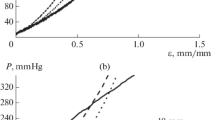Conclusions
-
1.
A method was developed for studying the mechanical properties of blood vessels subjected to internal pressure, based on x-ray vasography, which permits measurement of the internal diameter and thickness of the vascular wall in several projections and study of various intravascular structures and deformations.
-
2.
The effect of the degree of atherosclerosis of human arteries on their elastic properties was studied. A significant increase in vascular rigidity was noted with increasing atherosclerotic damage. The physical constants of the human common carotid arterial wall were determined for different degrees of atherosclerosis.
-
3.
The effect of atherosclerosis on the stenotic effect of a vascular anastomosis was studied. The narrowing of the anastomosis is more pronounced with increasing damage and relative vascular wall thickness.
-
4.
A mathematical model was developed for the stenotic effect of a vascular anastomosis which permits prediction of the stenosis of sclerotic and undamaged arteries upon change in pressure and relative thickness of the vascular wall.
-
5.
The results of this study may be used in reconstructive vascular surgery in the selection of the most promising method for the suturing of blood vessels.
Similar content being viewed by others
Literature cited
A. V. Mel'nikov, “The stenotic effect of some types of vascular sutures,” in: Abstracts of the All-Union Scientific Conference on Age-Related Morphology [in Russian], Vol. 1, Tashkent (1972), p. 105.
N. N. Zavalishin, V. M. Sagalevich, and V. I. Loshchilov, “Deformations and stresses in an elastic orthotropic tube with a ring concentrator in pulsation,” Mekh. Polim., No. 3, 490–495 (1978).
G. Gyurko and I. Furka, “Stenosing effect of vessel sutures,” Cardiovasc. Surg.,8, No. 5, 379–385 (1967).
R. H. Cox, “Anisotropic properties of the canine carotid artery in vitro,” Biomechanics,8, No. 5, 293–300 (1975).
C. Hartung, “Vascular tissues — a two-phase material?” in: Biopolym. Biomech., Bindegewebssyst., Berlin (1974), pp. 211–220.
É. É. Tseders, V. A. Kas'yanov, and B. A. Purinya, “Deformation of the human abdominal aorta upon diaxial tensile stressing,” Mekh. Polim., No. 3, 507–513 (1974).
É. É. Tseders and B. A. Purinya, “The mechanical properties of human blood vessels related to their site,” Mekh. Polim. No. 2, 320–325 (1975).
V. A. Kas'yanov and I. V. Knets, “A function for the energy of deformation of large human blood vessels,” Mekh. Polim., No. 1, 122–128 (1974).
V. M. Sagalevich and N. N. Zavalishin, “The mechanical characteristics of medium human blood vessels,” Mekh. Polim., No. 4, 708–711 (1978).
Y. C. Fung, “A mathematical model for the stress-deformation relationship for living soft tissues,” Mekh. Polim., No. 5, 850–867 (1975).
V. A. Kas'yanov, “An anisotropic nonlinearly elastic model of large human blood vessels,” Mekh. Polim., No. 5, 874–884 (1974).
B. A. Purinya and V. A. Kas'yanov, “The mechanical properties of the wall of the human abdominal aorta after endarterectomy,” Mekh. Polim., No. 4, 696–700 (1975).
B. A. Purinya and V. A. Kas'yanov. “Age-related changes in the mechanical properties of human coronary arteries,” Mekh. Polim., No. 2, 277–282 (1977).
B. A. Purinya, G. L. Vilka, Yu. K. Vilks, V. A. Kas'yanov, and É. É. Tseders, “Changes in a series of mechanical properties of human blood vessels with age,” Mekh. Polim., No. 1, 129–136 (1974).
S. Stoichev, “The stress-deformation relationship for large human arteries,” Mekh. Komp. Mater., No. 1, 92–99 (1980).
C. L. Berry, S. E. Greenwald, and J. F. Rivett, “Static mechanical properties of the developing and mature rat aorta,” Cardiovasc. Res.,9, No. 5, 669–678 (1975).
É. É. Tseders, T. S. Labadze, B. A. Purinya, V. A. Kas'yanov, and G. I. Mchedlishvili, “The mechanical properties of the canine internal carotid artery in static stress regimes,” Mekh. Polim., No. 4, 702–706 (1976).
F. Brian and M. Jabouley, “Recherches Experimentales sur la Suture et la Graffe Artèrielle,” Lyon Med.,81, January, 97–101 (1896).
H. Schumaker and R. Lowenberg, “Comparison of the method of the suture end-to-end,” Surgery,24 (1948).
Yu. N. Krivchikov, Methods of Attachment and Shunting of Blood Vessels [in Russian], Kiev (1966).
Author information
Authors and Affiliations
Additional information
Translated from Mekhanika Kompozitnykh Materialov, No. 2, pp. 336–342, March–April, 1982.
Rights and permissions
About this article
Cite this article
Vagner, E.A., Sukhanov, S.G. & Aptukov, V.N. Mechanical behavior of vascular anastomoses in sclerotic arteries and a model for this behavior. Mech Compos Mater 18, 240–245 (1982). https://doi.org/10.1007/BF00604849
Received:
Issue Date:
DOI: https://doi.org/10.1007/BF00604849




